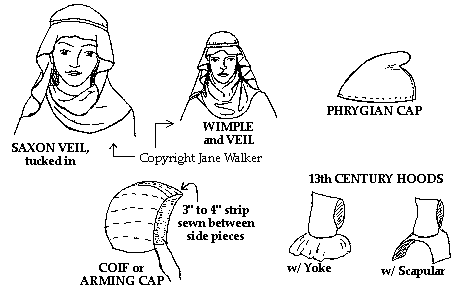
HEADWEAR 3/4/02
Proper headwear is essential to socially acceptable clothing, especially for women. Usually a veil or coverchief is sufficient, simply a white linen oval draped over the head and secured with a narrow band or fillet. Saxon women wrapped the back end of the veil around the front of the neck, tucking it in at the back again--the veil needs to be at least a yard long for this. Fashionable Norman ladies and anyone from later years wore the veil loose over the wimple, a wide linen band wrapped under the chin and pinned at the top of the head. Norse women wore a simple linen or silk cap like a small hood.
Phrygian caps are commonly seen on men in Saxon artwork, but there is now some thought that they may have been an artistic fashion and not so common in reality. Nevertheless, they are still considered acceptable in fabric or leather. The exact pattern is unknown--they may have been cut to the shape shown below, but more likely were simply a slightly pointed cap with the peak flopped forward.
In the 12th and 13th centuries, linen coifs or padded arming caps were in general use, and were worn under hoods and hats as well as alone or with a helmet. Norman men in the 11th century, however, appear to have gone bareheaded, though they probably wore padded caps beneath helmets or mail coifs.
Hoods have
been discovered at the 10th century Norse town of Hedeby, but they don't
seem to have been used by the rest of Europe until the 13th century.
It was common just to pull a fold of the cloak over one's head when necessary.

|
|
|
|
|
|
|
|
|
|
|